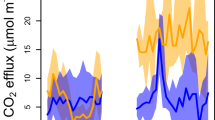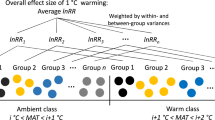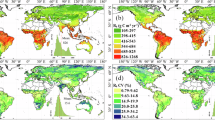Abstract
The effects of long-term climate warming on soil respiration and its drivers remain unclear in forests, which store approximately 40% of global soil carbon. Here we conducted a climate change experiment for 13 years in forest plots planted with tree juveniles at two southern boreal forest sites. Treatments included simultaneous above- and below-ground warming (ambient, +1.7 °C and +3.3 °C) under different rainfall scenarios (100% and 60% of summer rainfall) and contrasting overstory canopy openness (open and closed). Soil respiration increased by 7% and 17% under +1.7 °C and +3.3 °C warming, respectively, averaged across all sites, treatments and years. These increases in respiration were higher than impacts per degree warming of the only two prior long-term, but soil-only, forest warming experiments. Moreover, warming effects on soil respiration varied significantly over time. Under almost all conditions, moist soil exhibited a greater increase in respiration in response to warming than dry soil. Our results suggest that a realistic range of anticipated conditions, including both above- and below-ground temperature and moisture, should be accounted for when predicting warming effects on soil respiration.
This is a preview of subscription content, access via your institution
Access options
Access Nature and 54 other Nature Portfolio journals
Get Nature+, our best-value online-access subscription
$32.99 / 30 days
cancel any time
Subscribe to this journal
Receive 12 print issues and online access
$259.00 per year
only $21.58 per issue
Buy this article
- Purchase on SpringerLink
- Instant access to full article PDF
Prices may be subject to local taxes which are calculated during checkout




Similar content being viewed by others
Data availability
All data used and source data for figures and tables in this study are archived in figshare (https://doi.org/10.6084/m9.figshare.26488219.v1)35.
Code availability
The R scripts needed to reproduce the analysis are archived in figshare (https://doi.org/10.6084/m9.figshare.26488219.v1)35.
References
Scharlemann, J. P. W., Tanner, E. V. J., Hiederer, R. & Kapos, V. Global soil carbon: understanding and managing the largest terrestrial carbon pool. Carbon Manag. 5, 81–91 (2014).
Crowther, T. W. et al. Quantifying global soil carbon losses in response to warming. Nature 540, 104–108 (2016).
Bond-Lamberty, B. & Thomson, A. Temperature-associated increases in the global soil respiration record. Nature 464, 579–582 (2010).
Davidson, E. A. & Janssens, I. A. Temperature sensitivity of soil carbon decomposition and feedbacks to climate change. Nature 440, 165–173 (2006).
Schlesinger, W. & Andrews, J. Soil respiration and the global carbon cycle. Biogeochemistry 48, 7–20 (2000).
Soong, J. L., Phillips, C. L., Ledna, C., Koven, C. D. & Torn, M. S. CMIP5 models predict rapid and deep soil warming over the 21st century. J. Geophys. Res. Biogeosci. 125, e2019JG005266 (2020).
Pan, Y. et al. A large and persistent carbon sink in the world’s forests. Science 333, 988–993 (2011).
Sherwood, S. & Fu, Q. A drier future? Science 343, 737–739 (2014).
Seager, R. et al. Dynamical and thermodynamical causes of large-scale changes in the hydrological cycle over North America in response to global warming. J. Clim. 27, 7921–7948 (2014).
Wang, Y., Hogg, E. H., Price, D. T., Edwards, J. & Williamson, T. Past and projected future changes in moisture conditions in the Canadian boreal forest. For. Chron. 90, 678–691 (2014).
Way, D. A., Crawley, C. & Sage, R. F. A hot and dry future: warming effects on boreal tree drought tolerance. Tree Physiol. 33, 1003–1005 (2013).
Ma, Z. et al. Regional drought-induced reduction in the biomass carbon sink of Canada’s boreal forests. Proc. Natl Acad. Sci. USA 109, 2423–2427 (2012).
Schimel, J. P. Life in dry soils: effects of drought on soil microbial communities and processes. Annu. Rev. Ecol. Evol. Syst. 49, 409–432 (2018).
Zhou, Z., Wang, C. & Luo, Y. Response of soil microbial communities to altered precipitation: a global synthesis. Glob. Ecol. Biogeogr. https://doi.org/10.1111/geb.12761 (2018).
Zhou, L. et al. Interactive effects of global change factors on soil respiration and its components: a meta-analysis. Glob. Change Biol. 22, 3157–3169 (2016).
Schindlbacher, A. et al. Soil respiration under climate change: prolonged summer drought offsets soil warming effects. Glob. Change Biol. 18, 2270–2279 (2012).
Frelich, L. E. & Reich, P. B. Spatial patterns and succession in a Minnesota southern‐boreal forest. Ecol. Monogr. 65, 325–346 (1995).
Rich, R. L. et al. Design and performance of combined infrared canopy and belowground warming in the B4WarmED (Boreal Forest Warming at an Ecotone in Danger) experiment. Glob. Change Biol. 21, 2334–2348 (2015).
Hursh, A. et al. The sensitivity of soil respiration to soil temperature, moisture, and carbon supply at the global scale. Glob. Change Biol. 23, 2090–2103 (2017).
Chen, J. et al. Differential responses of carbon‐degrading enzyme activities to warming: implications for soil respiration. Glob. Change Biol. 24, 4816–4826 (2018).
Melillo, J. M. et al. Long-term pattern and magnitude of soil carbon feedback to the climate system in a warming world. Science 358, 101–105 (2017).
Song, J. et al. A meta-analysis of 1,119 manipulative experiments on terrestrial carbon-cycling responses to global change. Nat. Ecol. Evol. 3, 1309–1320 (2019).
Giardina, C. P., Litton, C. M., Crow, S. E. & Asner, G. P. Warming-related increases in soil CO2 efflux are explained by increased below-ground carbon flux. Nat. Clim. Change 4, 822–827 (2014).
Leuzinger, S. et al. Do global change experiments overestimate impacts on terrestrial ecosystems? Trends Ecol. Evol. 26, 236–241 (2011).
Carey, J. C. et al. Temperature response of soil respiration largely unaltered with experimental warming. Proc. Natl Acad. Sci. USA 113, 13797–13802 (2016).
Reich, P. B. et al. Even modest climate change may lead to major transitions in boreal forests. Nature 608, 540–545 (2022).
Lim, H. et al. Boreal forest biomass accumulation is not increased by two decades of soil warming. Nat. Clim. Change 9, 49–52 (2019).
Bond-Lamberty, B., Wang, C. & Gower, S. T. A global relationship between the heterotrophic and autotrophic components of soil respiration? Glob. Change Biol. 10, 1756–1766 (2004).
Kuzyakov, Y. & Larionova, A. A. Root and rhizomicrobial respiration: a review of approaches to estimate respiration by autotrophic and heterotrophic organisms in soil. J. Plant Nutr. Soil Sci. 168, 503–520 (2005).
Yang, L. et al. Soil microbial respiration adapts to higher and longer warming experiments at the global scale. Environ. Res. Lett. 18, 034044 (2023).
Bond‐Lamberty, B. et al. Twenty years of progress, challenges, and opportunities in measuring and understanding soil respiration. JGR Biogeosci. 129, e2023JG007637 (2024).
Kwatcho Kengdo, S. et al. Long‐term soil warming alters fine root dynamics and morphology, and their ectomycorrhizal fungal community in a temperate forest soil. Glob. Change Biol. 28, 3441–3458 (2022).
Stefanski, A., Bermudez, R., Sendall, K. M., Montgomery, R. A. & Reich, P. B. Surprising lack of sensitivity of biochemical limitation of photosynthesis of nine tree species to open‐air experimental warming and reduced rainfall in a southern boreal forest. Glob. Change Biol. 26, 746–759 (2020).
Bermudez, R., Stefanski, A., Montgomery, R. A. & Reich, P. B. Short- and long-term responses of photosynthetic capacity to temperature in four boreal tree species in a free-air warming and rainfall manipulation experiment. Tree Physiol. 41, 89–102 (2021).
Liang, G. et al. The dataset and R code for the paper “Soil respiration response to decade-long warming modulated by soil moisture in a boreal forest” in Nature Geoscience, 2024. figshare https://doi.org/10.6084/m9.figshare.26488219.v1 (2024).
Acknowledgements
We acknowledge support from the many field assistants who were involved in implementing and maintaining the experimental facility, the experimental planting and the measurements of soil respiration presented in this paper. This research was supported by the US Department of Energy (DOE), Office of Science and Office of Biological and Environmental Research award number DE-FG02-07ER64456; the National Science Foundation, Biological Integration Institutes grant NSF-DBI-2021898; DOE National Institute for Climate Change Research award; DOE Global Change Education Program; Minnesota Agricultural Experiment Station MN-42-030 and MN-42-060; and the College of Food, Agricultural and Natural Resources Sciences and Wilderness Research Foundation, University of Minnesota.
Author information
Authors and Affiliations
Contributions
P.B.R., R.A.M., R.L.R. and S.E.H. conceived and designed the original experiment and the experimental warming and rainfall manipulations. P.B.R., A.S., R.B. and R.L.R. managed the experiment over time. A.S., R.B. and R.L.R. collectively implemented the experiment. A.S., R.B. and W.C.E. supervised or performed the acquisition of all soil respiration data. A.S., R.B. and R.L.R. acquired all soil temperature and moisture and rainfall data, and curated all data. G.L. and P.B.R. developed the idea for this study. G.L. carried out all analyses with suggestions from P.B.R. and S.E.H., constructed the figures and tables and wrote the first draft. All authors contributed to the interpretation of the results and were involved in writing and editing subsequent drafts. P.B.R. and R.A.M. were responsible for acquiring the funding for the project, and P.B.R. was responsible for all project supervision and administration.
Corresponding authors
Ethics declarations
Competing interests
The authors declare no competing interests.
Peer review
Peer review information
Nature Geoscience thanks Jennifer Watts and the other, anonymous, reviewer(s) for their contribution to the peer review of this work. Primary Handling Editor: Xujia Jiang, in collaboration with the Nature Geoscience team.
Additional information
Publisher’s note Springer Nature remains neutral with regard to jurisdictional claims in published maps and institutional affiliations.
Extended data
Extended Data Fig. 1 Change in annual soil respiration and stem biomass caused by warming under different treatments at two sites (CFC and HWRC) over 13 years.
Panels under “Closed canopy (Ambient rainfall)” and “Open canopy (Ambient rainfall)” show results under different overstory canopy openness; panels under “Open canopy (Ambient rainfall)” and “Open canopy (Rainfall reduction)” show results under different rainfall amounts. Panels a, b, c and d show the results of the changes in RS, RH, RA and stem biomass caused by warming, respectively. Arrows represent the period that rainfall reduction treatment was applied. Error bars are standard errors of the mean for each treatment combination. The results from all plots before the beginning of rainfall treatments (<2012) were used for both “Open canopy (Ambient rainfall)” and “Open canopy (Rainfall reduction)”; therefore, identical results before 2012 were shown for both treatments. RS: soil total respiration; RH: soil heterotrophic respiration; RA: soil autotrophic respiration. The sample size was 3 for all treatments in each year at each site.
Extended Data Fig. 2 Mean soil respiration and stem biomass averaged across all measurements at two sites (experimental warming × overstory canopy openness).
Panels a, b, c and d show he results of RS, RH, RA and stem biomass, respectively. Error bars are standard errors of the mean for each treatment combination. RS: soil total respiration; RH: soil heterotrophic respiration; RA: soil autotrophic respiration. The sample size was 6 and 3 under closed and open canopy, respectively.
Extended Data Fig. 3 Mean soil moisture averaged across all measurements at two sites.
Error bars are standard errors of the mean for each treatment combination. For panel a, the sample size was 6 and 3 under closed and open canopy, respectively; for panel b, the sample size was 3 for all treatment combinations.
Extended Data Fig. 4 Mean soil respiration and stem biomass averaged across all measurements at two sites (experimental warming × rainfall amount).
Panels a, b, c and d show the results of RS, RH, RA and stem biomass, respectively. Error bars are standard errors of the mean for each treatment combination. RS: soil total respiration; RH: soil heterotrophic respiration; RA: soil autotrophic respiration. For RS and RA, the sample size was 6; for RH and stem biomass, the sample size was 3.
Extended Data Fig. 5 The relationship between stem biomass and soil respiration (a-c) and between the changes in stem biomass and soil respiration caused by warming (d-f).
Simple linear regressions were conducted, and P values were shown only when P < 0.1. The mean values across years from each plot were used to determine the relationships in panels a-c; the mean values of each block from each year were used to determine the relationships in panels d-f.
Extended Data Fig. 6 The change in soil respiration caused by experimental warming under different percentiles of ambient soil moisture.
Panels under “Closed canopy (Ambient rainfall)” and “Open canopy (Ambient rainfall)” show results under different overstory canopy openness; panels under “Open canopy (Ambient rainfall)” and “Open canopy (Rainfall reduction)” show results under different rainfall amounts. Ambient soil moisture is soil moisture under ambient warming treatment. Panels a and b show the results of the changes in RH and RA caused by warming, respectively. The measurements of soil moisture and respiration from all campaigns over 13 years were used. RH: soil heterotrophic respiration; RA: soil autotrophic respiration. Values in the parentheses represent the sample size under different percentiles for each treatment combination.
Extended Data Fig. 7 Three-year rolling mean change in annual soil respiration and stem biomass under experimental warming relative to ambient treatment.
Panels under “Closed canopy (Ambient rainfall)” and “Open canopy (Ambient rainfall)” show results under different overstory canopy openness; panels under “Open canopy (Ambient rainfall)” and “Open canopy (Rainfall reduction)” show results under different rainfall amounts. Panels a, b and c show the results of the changes in RH, RA and stem biomass caused by warming, respectively. No data were shown for “09-11”, “10-12”, and “11-13” under Open canopy (Rainfall reduction) treatment because rainfall reduction treatment was conducted in 2012. RH: soil heterotrophic respiration; RA: soil autotrophic respiration.
Supplementary information
Supplementary Information
Supplementary Figs. 1–7 and Tables 1–3.
Rights and permissions
Springer Nature or its licensor (e.g. a society or other partner) holds exclusive rights to this article under a publishing agreement with the author(s) or other rightsholder(s); author self-archiving of the accepted manuscript version of this article is solely governed by the terms of such publishing agreement and applicable law.
About this article
Cite this article
Liang, G., Stefanski, A., Eddy, W.C. et al. Soil respiration response to decade-long warming modulated by soil moisture in a boreal forest. Nat. Geosci. 17, 905–911 (2024). https://doi.org/10.1038/s41561-024-01512-3
Received:
Accepted:
Published:
Issue date:
DOI: https://doi.org/10.1038/s41561-024-01512-3
This article is cited by
-
Various responses of global heterotrophic respiration to variations in soil moisture and temperature enhance the positive feedback on atmospheric warming
Communications Earth & Environment (2025)
-
Short-term warming increased soil heterotrophic respiration due to enhanced active microbial community
Plant and Soil (2025)
-
Soil CO2 and CH4 response to experimental warming under various tree species compositions in a temperate harwood forest
Discover Soil (2025)
-
Microbial photosynthesis mitigates carbon loss from northern peatlands under warming
Nature Climate Change (2025)



